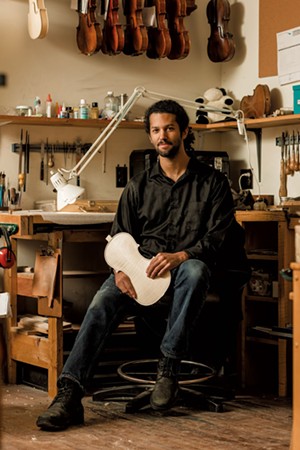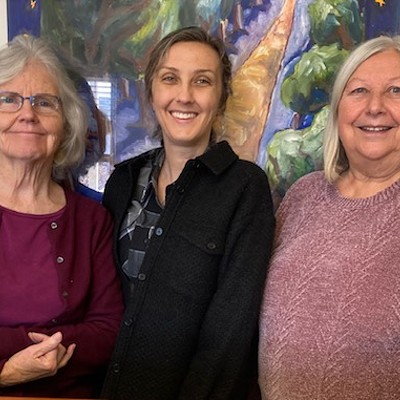
- Oliver Parini
Name: Marcus Bretto
Job: Violin maker
Town: Burlington
The violin as we know it today dates back to 16th-century northern Italy. The region spawned dynasties of violin makers, whose names are still synonymous with quality: Giuseppe Guarnari, Antonio Stradivari, the Amati family. Some of the oldest and most sought-after violins, housed in museums, were made by masters more than 500 years ago.
Marcus Bretto is only 24 years old, but he's been making music and designing instruments nearly his entire life. Having tinkered in the craft as a child, he built his first violin from a kit at age 14. After high school, he immediately entered the private vocational North Bennet Street School in Boston, where he studied violin making for three years with the same rigor as others might pursue a college degree. The first two weeks of his studies were dedicated to learning how to sharpen his tools; the first violin he built from scratch took his entire first year.
Today, living in Burlington, he works full time as a luthier — one who makes stringed instruments — for Vermont Violins, as well as on his own projects in the Generator maker space.
To make his violins, Bretto uses pieces of wood worth hundreds of dollars, and every cut must be precise within one-tenth of a millimeter. Many of the violins he makes for Vermont Violins cost $4,000 to $5,000, and a top-end violin can cost as much as $10,000. According to Bretto, they're made to last the violinist's entire life.
"Violin making, in general, is one of those things that's very easy to get lost in," Bretto said. Seven Days spoke with him about the work that goes into a violin and how the craft is changing.
SEVEN DAYS: How did you get interested in instrument making?
MARCUS BRETTO: It really started back when I was maybe 3 years old. Because my dad is a musician, I had all these instruments surrounding me, even back at that age. I always liked to change things around and see what kind of weird sounds I could make. When I was older, I started making instruments out of basically whatever was around the house — rubber bands and strings and cardboard boxes.
I didn't know it was a thing that people really did, and made a career out of, until sixth grade, because that's when I started playing the violin and doing actual woodworking classes at my school.
SD: Walk us through the timeline of making one instrument. How long does it take, and what are the steps?
MB: Most people make between seven and 12 instruments a year, so it usually takes about a month and a half of full-time work.
It starts off with choosing the outline of the instrument and building what's called the rib structure. You have the top plate on top and the back plate, and the rib structure is the thin band joining those two plates that actually makes it into a box. You use the rib structure to base the outlines for your top and your back plates.
You start out with a section of a log, and you split it right down the middle so that you have essentially a mirror image of wood on either side, so it has the same tonal properties on both sides. Those two pieces are then perfectly joined together [by the rib structure].
Those [top and back plates] get carved out, basically by hand. All of that arching and flowing is carved with what's called finger planes, removing small bits.
That's when most people will put in the neck and work on the fingerboard of the instrument. That's pretty nearly the finished instrument, before varnishing and other setup stuff.
SD: What are the main differences between a lower-end violin and a $10,000 violin?
MB: There's the materials, that's one thing. And a lot of it is the attention to detail and the labor that goes into making the instrument. You can make a violin-shaped object. You see them all the time on eBay for like $150 or $200. It looks like a violin, and it performs the basic job of a violin, but all of the attention to detail that makes one actually work and sound good or even last for a long period of time is completely not there.
SD: What are you working on at Vermont Violins?
MB: When I started there, a lot of it was repair work. We have a rental line, as well, and I was making sure the instruments that are there, that people can rent, are in good condition and ready to go.
But now it's pretty much full-time making for me. We went from making maybe one every two months when I came in to making two a week.
We actually have three shops. There's one in New Hampshire and one in Montpelier. There are eight people that are part of the process. It's a team effort, really.
What we're working on is kind of really special. We're merging the technology, like a high-precision CNC machine and things like that, with hand skills to produce these instruments that are really quite good for most advanced-level musicians but aren't nearly the cost of an entirely handmade instrument.
SD: Is there any resistance against using machining and technology in the violin world?
MB: There definitely used to be. And it's still there, to a certain degree. I think it all depends how you use these tools. Those machines are incredible. They can make things absolutely perfect. But it's not so much the dimensions that matter. They do, but also the flowing of the shapes and the concept — and realizing that every piece of wood that you use to build one is going to be different. A machine can't feel that — yet.
SD: What's the difference between a fiddle and a violin?
MB: A fiddle has beer spilled on it. [Laughs.] Essentially, there isn't really any difference in the instrument itself, more the genre that people want to play.
This interview has been edited and condensed for clarity and length.





Comments (2)
Showing 1-2 of 2
Comments are closed.
From 2014-2020, Seven Days allowed readers to comment on all stories posted on our website. While we've appreciated the suggestions and insights, right now Seven Days is prioritizing our core mission — producing high-quality, responsible local journalism — over moderating online debates between readers.
To criticize, correct or praise our reporting, please send us a letter to the editor or send us a tip. We’ll check it out and report the results.
Online comments may return when we have better tech tools for managing them. Thanks for reading.